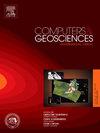Zero watermarking for vector geographic point data based on convex layers
IF 4.2
2区 地球科学
Q1 COMPUTER SCIENCE, INTERDISCIPLINARY APPLICATIONS
引用次数: 0
Abstract
Zero watermarking plays a critical role in the copyright protection of vector geographic data in geographic information industries, as it does not distort the data. However, how to extract stable features from vector geographic point data is still a challenging problem. A zero watermarking method based on convex layers is proposed to address the issue. First, the vector geographic point data is simplified as a point set. Next, construct convex layers from the point set through convex hull peeling or onion peeling. Then, calculate the density of vertices wrapped within each convex hull of the convex layers to obtain an integer number sequence. Finally, the sequence of vertex density is binarized to the watermark by comparing each value with its adjacent counterparts. Experiments substantiate the theoretical achievements of the proposed method. Its normalized correlation coefficient always keeps at 1.00 when suffering rotation, uniform scaling, non-uniform scaling, translation attacks, and map projection transformation attacks, demonstrating superior robustness compared to the existing methodologies. The watermark uniqueness has also been verified through the analysis of a set of 100 randomly generated point datasets.
基于凸层的矢量地理点数据零水印
零水印不失真,在地理信息产业矢量地理数据的版权保护中起着至关重要的作用。然而,如何从矢量地理点数据中提取稳定特征仍然是一个具有挑战性的问题。针对这一问题,提出了一种基于凸层的零水印方法。首先,将矢量地理点数据简化为点集。接下来,通过凸壳剥离或洋葱剥离,从点集构建凸层。然后,计算包覆在凸层每个凸包内的顶点密度,得到一个整数序列。最后,将顶点密度序列与相邻的顶点密度序列进行比较,二值化为水印。实验验证了该方法的理论成果。在遭受旋转、均匀缩放、非均匀缩放、平移攻击和地图投影变换攻击时,归一化相关系数始终保持在1.00,与现有方法相比,具有更好的鲁棒性。通过对随机生成的100个点数据集的分析,验证了水印的唯一性。
本文章由计算机程序翻译,如有差异,请以英文原文为准。
求助全文
约1分钟内获得全文
求助全文
来源期刊

Computers & Geosciences
地学-地球科学综合
CiteScore
9.30
自引率
6.80%
发文量
164
审稿时长
3.4 months
期刊介绍:
Computers & Geosciences publishes high impact, original research at the interface between Computer Sciences and Geosciences. Publications should apply modern computer science paradigms, whether computational or informatics-based, to address problems in the geosciences.
 求助内容:
求助内容: 应助结果提醒方式:
应助结果提醒方式:


